|
Mike Mentzer's
High Intensity Workout and his training ideas: ALSO
KNOW AS HIT (High Intensity Training).
Mike Mentzer's training
theory is well described in his book, "High Intensity Training",
printed in 2003 and very well written by Mike and John Little.
You would be well served to read this book. It really makes you
think. He backs up his training ideas with a lot of medical evidence.
The crux of his workout theory is: train super hard, and briefly--the
more advanced you get the less you train (as you make inroads into
your limited recovery ability)--and then you REST. A minimum 4-6
days and up to 14 days between workouts to allow maximum recovery.
Upward progress is constant as you simply rest more and train harder,
workout by workout.
In the book Mentzer
states: I f you stop making progress stop training for 2 weeks and
resume again. The idea is to recuperate, from intense training and
always return to the gym stronger. A never ending upward spiral
of success as long as you can induce a maximum contraction on the
muscle as that is the trigger (and the only trigger according to
Mike) to make the muscle grow, and then REST to allow that growth
to take place. Got it?
It sounds very scientific
and and makes sense. The harder you work the more you rest. Sounds
logical. And I can agree on that point but unfortunently not on
much else.
The
body doesn't work that way.
Mike gives us tomes
of empirical, evidence to back up his claims. Yet I can tell you
from years of experience, that truthfully, the body does not respond
that way to exercise.
Mike is one of my favorite
bodybuilders. I have read almost every article and every book he
has written. I have trained using one set only to failure (and beyond)
on 9 exercises for almost a year. Here is what I learned: I got
very strong on those exercises. Very strong. I didn't grow. I got
hurt a lot (and so did my partner).
Yes the sad fact is I
didn't get any bigger and weighed the same. Yes I could leg curl
nearly 60lbs more than the year before, but I was no bigger. Zip.
Nothing. Nada.
Injuries
I got hurt. A lot. High
intensity as described by Mike is very dangerous. Pushing yourself
super hard is bad for you. I don't care how much you rest between
training sessions.
How bad is bad? Let me
tell you: I was doing negative only training and tore my shoulder
out of the socket. I was leg pressing and was pushing so hard with
so much weight I broke bones in my ankle. I puked quite often during
my training and I blacked out once during a set. I trained very
hard. We would tie our hands to the lat pull (on every set so you
couldn't lose your grip and quit) with 6 foot boxing straps and
pulled till our arms nearly popped out of the sockets! And finally
during one set of mega squats I ruptured my stomach wall and had
to visit the hospital for an operation. And this is not the entire
list of injuries!
The fact is as you become
advanced (strong) you can push yourself beyond your limits very
easily. You can and will, injure yourself. Pushing yourself too
hard, too often, is not good for you.
THE SET THING.
The moment I returned
to multiple sets training (which I did to see what might happen)
with less intensity (let's call it normal intensity or hard work)
I grew. I'll never forget it. The evidence was irrefutable. One
set to failure may make you stronger, but it does not build a physique,
and it's dangerous. And resting weeks between workouts is no way
to become strong and fit. Though I have to admit I never have tried
taking weeks off between workouts unless I was very hurt or sick.
Yes, I was stronger
from the one set stuff as I stated earlier, (I gained what I usually
gain in strength training) and using that strength in multiple set
training was a plus, but NOT TILL I RETURNED to MULTIPLE NORMAL
SETS without training ot all out failure--did I start to hypertrophy
again. Maybe it's the blood flow. Maybe it's the high and low reps,
maybe it's the frequency, maybe the cenetral nervous system recovers
better when you are not training to failure all the time--maybe
it's all of it! All I can tell you is --it works.
It's possible, in fact
very easy, to get hurt doing things like negatives and forced
reps and rest pause techniques,especially if you train like that
ALL the time (instead of very infrequently
using high intensity, as I suggest---week 3 of your monthly cycle
during phase 3 of your yearly training--maxing only once a year.)
Mike has the athlete maxing out all the time and beyond!
It's not good for you unless your joints
and tendons are made of steel.
The body isn't meant
to do "forced reps", or all negative reps with a weight
you can't normally lift (there is a reason you can't lift it--it's
too heavy!). It damages your tendons, it puts you at risk.
And if you do it for several high intensity workouts in a row, maxing
out at every workout on every exercise--YOU WILL BECOME INJURED.
Mike says you won't get
hurt. You just need to rest more. I don't care how much REST you
take. 4 days, 14 days (even worse) walk in that gym and start maxing
out every workout and you're finished. In
no time you will be injured. I would bet money on it. Then you can
really rest as you wait to grow new tendons.
Let's just say that you
didn't get hurt? Would it work? Nope. 2 reasons: One: You need more
frequent exercise to get into good shape for one thing. Once a week
training (for 12 minutes to an hour) or less is not enough time,
training wise, to produce a fit healthy muscular body. I will admit
one hour of training a week can have marvelous benefits and it works
to build size, however to become Mr. America it is not enough training.You
need weights at least twice a week (training hard and progressively)
and more to really progress, and you need to do some sort of aerobics
and ab work. The second thing is you can't kill yourself year round
in the gym.It just doesn't work. Your central nervous system and
glands are overloaded from constant high stress. You must work hard
enough to improve, and progression means adding small amounts of
wieght to the bar on a consistent basis. You don't have to train
to failure to get stronger or 2 one or two more reps each week.
You have to work hard, or at least exert yourself, but you don't
have to kill yourself to make progress.
Training to failure each
time you lift is like running a sprint 100% till you drop each time
you run. It's not practical or needed to improve. Training with
all out intensity all the time can be very detrimental. You overload
your body (and mind) and you can't recover any more, growth stops
and you will probably shrink, you "go stale" as it were.
The body has a defense mechanism that after a few weeks of high
stress, kicks in and basically shuts itself down. I have seen it
over and over in my own life and in other trainers. Classic
signs of being stale beside being weak are: You
can't sleep, feel nervous, no appetite, tired, and usually you may
get a cold or flu as well. It's your bodies way of slowing you down
one way or another.
Athletes that go to the
Olympics to run for example, don't run fast all year round. They
build up to it. They peak themselves. They train and run a little
faster each month and then at the Olympics they give 100%. Then
back off and do it again next year, with a new training cycle It's
the best way to prepare to be your best. No one runs the 4 minute
mile every day. You build up to it, do it, then back off. To run
a 4 minute mile every day would be impossible, even if you rested
2 weeks between runs you would still find yourself slowing down.
The body can only run at maximum for a short time then it needs
down time to attempt that pace again. You can't stay at a peak.
It's very difficult and prone to injury (after all, now you are
at your physical limits) as you ride the razors edge.
Mike's theory is based
on hard work and then rest. This is the basic idea behind conventional
training as well, however you max out very infrequently ( using
conventional training ) and the work is carried out over a year's
time.
Mike completely discounts
periodization and that is the major flaw in his training theory
(besides way too much rest between training sessions). You simply
can't kill yourself all the time in the gym. The nervous system
and endocrine systems can only take a few weeks of this, at best,
and then you go VERY VERY STALE. So even if your elbows and shoulders
don't get ripped from doing negative benches your nervous system
will overload very quickly from constant high intensity training.
Remember I am not knocking
Mike Mentzer. Mike was a great guy. His books are very informative
and influenced me to train both harder and for less time. I just
can't get behind the entire High Intensity Training (HIT) training
program. For me, and others, it was a dead end.
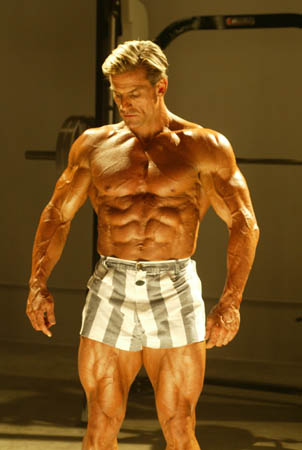
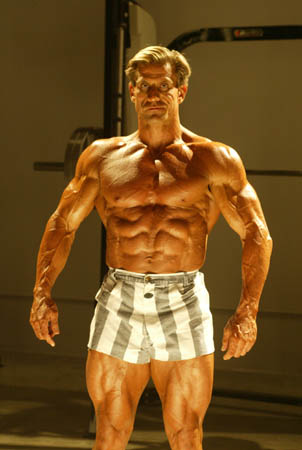
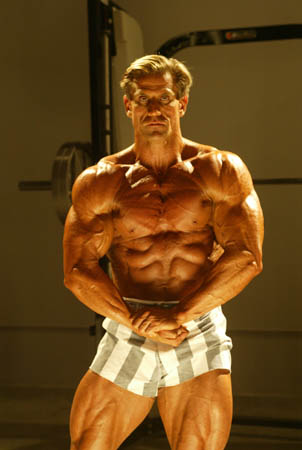
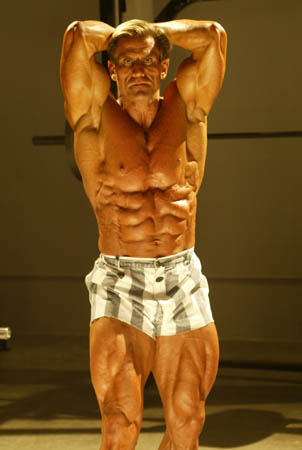
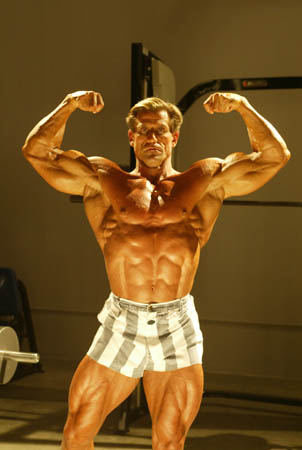
|
HEAVY TRAINING
The tendons that connect
all your bones and muscles are very strong, yet fragile. As your
muscles get stronger they will contract at greater levels, increasing
the load on your tendons and recovery ability. The tendons recover
very slowly, almost invisibly, it takes so long. We cannot feel
it, yet we know it is there. Well, once you injure a tendon you
will know it is there! But is there a way to avoid this injury?
Train heavy, at most
once a month, and only once a year to a max. Train using "cycles".
Build up to a peak of strength, then back off and do it again. Use
monthly cycles inside larger yearly cycles.
Now, heavy is relative..if
your max bench is 100lbs for 6 reps it would be safe to perform
that once a month. However, if you are really training heavy don't
go heavy all the time. Train in cycles (periodization),as shown
in this book. It is not needed, you won't recover from your workouts,
and constant heavy training will take years off the life of your
joints. When you do train heavy though..you go all out. You warm
up well..get mentally excited, and push as hard as you can in good
form.
How Often
Should you train?
Individuals with extreme vitality can train daily and make good
physical progress. These people are rare. Also they take years building
into and adapting to intense daily exercise. People like Jack LaLane,
Olympic gymnasts and so on. I am one of those people. But I have
seen many who are not. Most people make the best progress in gaining
size and strength from training 2 times a week progressively on
basic exercises. It's not fancy, but it works 90% of the time.
Train as often as you can but not more than you can tolerate. If
you can't recover from your training, you can't make progress. 1
to 2 hours of training a day would be fine for full time athletes
and people with high vitality, but most of us cannot do that nor
can most people recover properly from such a program. Learn what
amount of exercise you can recover from and work with in those limits.
If you are training 5 to 4 times a week and not getting anywhere,
cut back. If 3 times a week is too much, cut back.
Train as frequently as
per your training cycle, but again within your limits. Some people
can handle split training, some can't. When I return to high volume
training after a strength cycle, I gradually add more sets and reps
and exercises over the entire 4 month cycle. So should you. If you
have to make an error in judgment be conservative. If you find the
volume is too much and you feel run down, or your joints are very
sore, cut back.
My advice is to do abs
and cardio every other morning, even if only for 10 to 20 minutes.
After work in the evening do your weight training 2 or more times
per week for at least 45 minutes to 2 hours. If you train for 2
hours eat something during your training to keep the energy up.
Also eat the moment you are done training. If you are moving into
contest mode or higher volume work you can do your split training
or secondary exercises, on the weekends. During the week when you
are working, just train once on a training day following a basic
routine.
During the conditioning
phase you will train with a higher volume of exercises and train
more frequently, perhaps 2 or 3 times a day even ( taking the next
day off ). During your strength phase you will back off to 2 or
3 days a week or every 2 weeks ( resting 4 to 5 days between workouts
) depending on how difficult the workouts are to recover from, and
reduce the training volume to the basic heavy exercises. At the
end of the strength cycle you might be down to training once every
4th day or longer (it takes that long to recover from very heavy
training such as heavy deadlifts, squats and so on ). So it depends
what phase you are in as to how often you will train.
How Often
and How Long Should you train?: part 2.
I think my advice on
training frequency needs to be explored in additional depth. Most
of us are training to get bigger or stronger. These are very special
tasks. Different than being super fit, or a triathlete. If gaining
muscle and getting stronger is your goal read the following advice
very carefully. I tell you exactly what to do.
The danger when training
hard with weights, is too train too frequently. Besides progression
in the core lifts--You must recover between workouts to GROW muscles.
Every day or every other day training is too much exercise for the
individual trying to gain strength. You need to recover completely
between workouts to benefit from your efforts.
HOW
LONG SHOULD YOU TRAIN?
A hard 30 to 45 minute
workout with true intensity of effort is all that is required. Long
workouts, above 45 minutes of hard training, is counter productive.
Don't do it. Follow a hard workout with 2
or 3 or 4 days of rest and you will have allowed yourself enough
time to grow.
Daily
training is too much for MOST people. In fact the great majority
of people who are trying to GAIN muscle would be better served training
each body part once or twice a week, or twice every 2 weeks.
Is resting 3 to 4 days
between workouts too much rest? The answer
is no if you are training hard.
You must recover your
entire body between workouts. If you do legs on Monday and do them
hard, and then train upper body on Tuesday (or Wednesday) you are
not allowing any time to grow and recover from Mondays workout.
Better to train once
or twice or three times on a single day and then take several days
off completely--than to train once every day on a split routine.
This allows your body to recover fully from the workout day.
Train no more than 30
to 45 minutes if you can arrange it. Two, 45 minute workouts (done
on the same day) are better than one long 90 minute workout. Eat
and rest between each workout.
How do we split up the
body to train both upper body and lower body and allow enough rest
to grow? Here are some good schedules:
Train legs and uppers
in 2 separate workouts on one day, then rest 3 to 4 days, then repeat
this cycle. So Monday AM would be leg training, Monday PM would
be upper body, rest 3 to 4 days, train again.
Here is another good
schedule: Train legs on Monday and upper body on Friday. Repeat
the following week. Or train upper and lowers on Monday and repeat
Friday.
No time to train twice
a day? Try this routine: Train uppers on Monday and lowers on Tuesday
or Wednesday. Rest 2 or 3 days and repeat the cycle.
I can tell you one thing
about this routine and it's variations. It works. Don't spin
your wheels with daily workouts if you are not already very big
and strong.
The bottom line is REST
2 or 3 days between hard workouts. This type of training frequency
works when nothing else will. And it works for almost everyone.
Serious about gaining muscle? Rest several days between hard workouts.
Training every day is
great for fitness, being lean, and doing detail work. Training every
day is NOT productive for GAINING muscles.
How Hard
Should You Train? (HARD
ENOUGH TO MAKE PROGRESS)
How hard should
you train? At least 80% intensity (with a mind focused on progressing
in weight or reps on your core exercises) and sometimes even more.
Keep it enjoyable and train like you mean it. 2 good sets are worth
200 half hearted sets. FOCUS on your set. Push yourself. When the
muscles start to fail be sure it really is failure. Speaking of
which..I always advise my clients to train super super hard ( I
mean till the sweat is shooting out of your eyes) but stop your
sets 1 or 2 reps before failure (except for once or twice a month
during the super hard or peak workout for that month). It sounds
like conflicting advice but it is really the best way to avoid injury
and over training and it works.
Hard is a relative term.
It means different things to different people. Remember to workout
progressively and you can't miss. You don't have to kill yourself
to make progress.
Another good tip is to
follow a hard effort workout with a lighter workout. Even on your
all out heavy week (week three of the monthly cycle) you still don't
train 100% every day. Save it for one or two days on those special
lifts that make you big and strong (like squats and rows). 100%
effort, can burn you out fast. Train hard but don't leave the gym
with your hands shaking...that's too much. You have wracked your
nervous system and that is not the idea. Always train within
your limits, even as they expand year after year.
Here is an important
note. Just training hard is not the goal of training. Killing
yourself in the gym is not a guarantee of growth. Burning out on
set after set does very little to make you bigger if you
are lifting the same weights week after week. Many of us have heard
you must have 100% intensity to get anywhere. It is not practical
or necessary to kill yourself at each and every workout. It will
hinder your progress.
You can be sure you are
lifting hard enough IF YOU ARE MAKING PROGRESS in weight or reps
on your core exercises. Here is an example of a typical workout.
You squat 15 reps with 300lbs. Previously your best squat performance
was 15 reps with 290lbs. You finish the set with the 300lb and you
realize it felt easy, you are hardly breathing hard. You feel like
you can do even more. DON'T. Hold back. Progress is enough. Save
the energy to grow on. Add weight next time. Don't do any lighter
sets to failure or for a burn, just stop. You got stronger, that's
enough. Let the weights work their magic. Your job now is to eat,
rest and grow.
It's not necessary
to grind yourself into the ground to make progress. Train hard,
hard enough to improve, but not so hard you burn out.
Hard work is important
but do it intelligently without haste. Train within your limits.
You should not train so hard you become fearful of your workouts.
Train hard enough to progress but do not train so hard you cannot
properly recover from the workouts. Always leave the gym with energy.
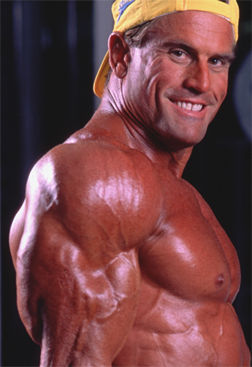
Rep speed
The fact is you have
to do several rep schemes in your overall training. Super slo reps
and medium reps are two examples of rep schemes.
There are slo reps. Super
slo reps. Medium reps. Fast reps done with force. Smooth reps with
a hold at the end. Stutter reps, rest pause reps, negative reps,
assisted reps, and isometric reps. All of these have a place in
your training. Give each one a fair chance, and you will come to
understand that each one has something to offer. The bottom line
is no matter what rep scheme you are using you must:
Lift progressively.
Add weight to the bar; i.e. get stronger.
Contract your muscles
hard with multiple sets of both high and low reps (not always at
the same workout). A good contraction, is very important.
Lift intensely but
not so hard you overtrain yourself.
Personally I go slow
for the first 4 reps of a set, intentionally trying to let the muscles
really feel those first reps and to be careful, then for the next
reps I try to mentally explode and or speed up the reps, however
the speed of the rep still looks smooth and slow as now I am tired
from the first slow reps. Though I am trying to push hard and fast
on the reps now, the bar is still moving slow. It takes practice
but this is a great way to get the most out of every set. If the
bar starts to move to fast, just slow down. You have to try to get
as much out of each rep and each set as possible.
Sometimes once I am warmed
up I might mix it up: I like doing 15 high rep squats with a medium
speed, then end with 5 super slo reps. That really kicks up the
intensity. Experiment with all rep schemes.
For the most part do
slow to medium reps. Never jerk or bounce the reps. Better slower
than faster.
Super Slow
TRAINING
Like other cycles
and methods of training Super Slo training is enjoying a big reassugance
as of this writing in 2004. There are even super slo gyms. I await
the day for the return of PLYOMETRIC gyms. Anyway..
Super slow reps
are just another way to approach a rep. It can be valuable and fun.
The standard
protocol is 10 to 20 second positives with 5 to 10 second negatives.
NO stopping, you do the rep slowly and smoothly. It takes practice
to perform correct super slow reps.
I like to do
my slow reps SUPER SLOW. Much slower than the norm (I do the normal
ones too). I have found that reps with a 30 to 50 second positives
and 20 to 30 second negatives, combined with stutter reps and static
holding (just stopping for a few seconds) can be very effective.
2 or 3 reps like this can be more than enough for 1 set.
I find Super
Slo a valuable tool in the bodybuilder's arsenal of tactics, but
it is not a magic routine. Do it for a few weeks or once in a while
do a super slo workout, it's excellent to use it with other rep
combinations. It's painful and takes real concentration to perform
correctly (like most good weight lifting) so give it several weeks
if you decide to practice this technique. Super slow training can
be fun. I get very intense contractions using it.
|

